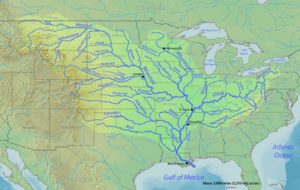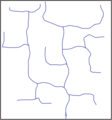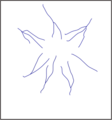River system facts for kids

A river system is like a giant network of natural waterways. It's also called a drainage system. Imagine all the rivers, streams, and smaller creeks in an area working together. This whole system collects and carries water within a specific region called a drainage basin.
Most of the time, water in a drainage basin eventually flows into the sea. But sometimes, the water might just evaporate into the air, or it could flow into a lake that has no outlet to the ocean. For example, Lake Chad is a famous lake in Africa that doesn't connect to the sea. Lakes like this are called endorheic lakes.
Contents
What is a River System?
A river system includes a main river and all its smaller branches, called tributaries. These tributaries are like smaller rivers or streams that join the main river. Think of it like the branches of a tree, all leading to the main trunk.
The Drainage Basin
The land area that collects all the water for a river system is known as a drainage basin. It's also sometimes called a watershed. When rain falls or snow melts within this basin, the water flows downhill, gathering into streams, then rivers, and finally into the main river.
Where Does the Water Go?
Most river systems are exorheic, meaning their water eventually reaches the ocean. They carry fresh water from the land to the sea. However, some river systems are endorheic, like the one feeding Lake Chad. Their water stays within the land, either evaporating or flowing into an inland lake without reaching the ocean.
How Rivers Shape the Land
Rivers are super important for shaping the Earth's surface. They act like natural conveyor belts, moving dirt, rocks, and other materials from higher areas to lower ones. This material is called sediment.
Moving Sediment
When water flows, it picks up tiny bits of rock and soil. This process is called erosion. Rivers carry this eroded material, especially from mountains and hills, all the way down to lakes or the sea. Over time, this movement can carve out valleys and canyons.
Dropping Sediment
Rivers don't just pick things up; they also drop them off. When a river slows down, it can't carry as much sediment. So, it drops the material, often building up new land. This can happen in the river's channel or on its floodplain.
River Parts: Channels and Floodplains
Rivers usually flow within specific paths on the land. These paths have special names.
The River Channel
The channel is the main path or ditch that a river flows through. It's like a natural trench carved into the land. Most of the time, the river's water stays inside its channel.
The Floodplain
The floodplain is the flat land next to the river channel. This area gets covered with water when the river overflows its banks during a flood. When the floodwaters go down, they often leave behind new, fertile soil, which is great for farming. Together, the channel and the floodplain make up what scientists call the "fluvial environment."
Images for kids
-
Dendritic drainage: the Yarlung Tsangpo River, Tibet, seen from space: snow cover has melted in the valley system.
-
The radial drainage network of Dogu’a Tembien in Ethiopia
See also
 In Spanish: Red de drenaje para niños
In Spanish: Red de drenaje para niños








